Rewards and Consumer Loyalty Schemes in UK Retail: Primark Case
VerifiedAdded on 2023/04/04
|25
|4479
|204
Project
AI Summary
This project investigates the effectiveness of rewards and consumer loyalty schemes in acquiring and retaining customers within the UK retail sector, using Primark as a case study. It begins with a research proposal outlining the study's objectives, including identifying the value of loyalty programs, assessing their contribution to Primark's business, evaluating associated issues, and suggesting solutions. The research employs a deductive approach with a descriptive design, utilizing quantitative data collected through online surveys of 30 Primark customers. Data analysis involves frequency and inferential techniques to interpret findings and provide recommendations for strategic changes in Primark's reward and loyalty programs to enhance customer retention and address identified challenges, such as limited offer applicability and heightened customer expectations. The study also reviews relevant literature to support its analysis and recommendations.
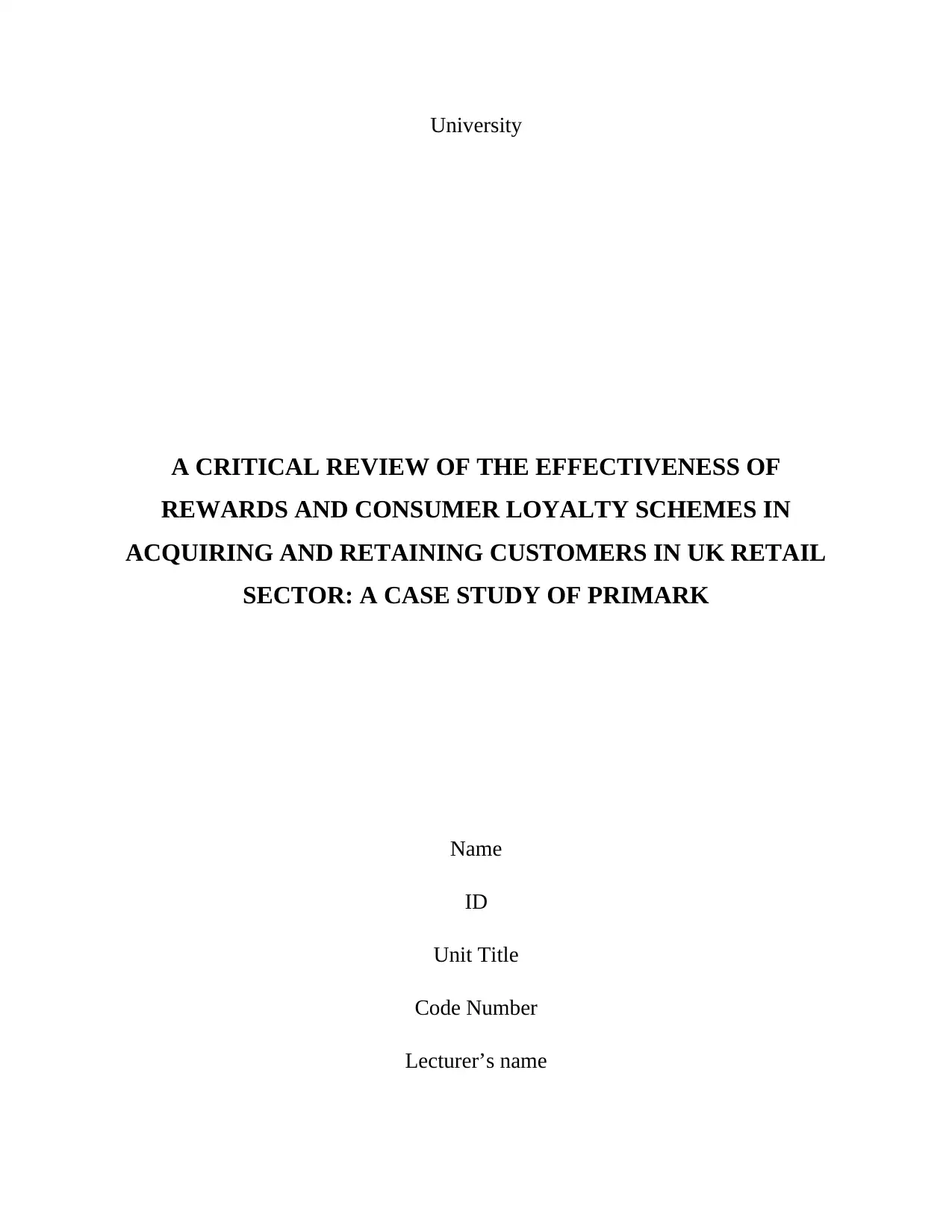
University
A CRITICAL REVIEW OF THE EFFECTIVENESS OF
REWARDS AND CONSUMER LOYALTY SCHEMES IN
ACQUIRING AND RETAINING CUSTOMERS IN UK RETAIL
SECTOR: A CASE STUDY OF PRIMARK
Name
ID
Unit Title
Code Number
Lecturer’s name
A CRITICAL REVIEW OF THE EFFECTIVENESS OF
REWARDS AND CONSUMER LOYALTY SCHEMES IN
ACQUIRING AND RETAINING CUSTOMERS IN UK RETAIL
SECTOR: A CASE STUDY OF PRIMARK
Name
ID
Unit Title
Code Number
Lecturer’s name
Paraphrase This Document
Need a fresh take? Get an instant paraphrase of this document with our AI Paraphraser
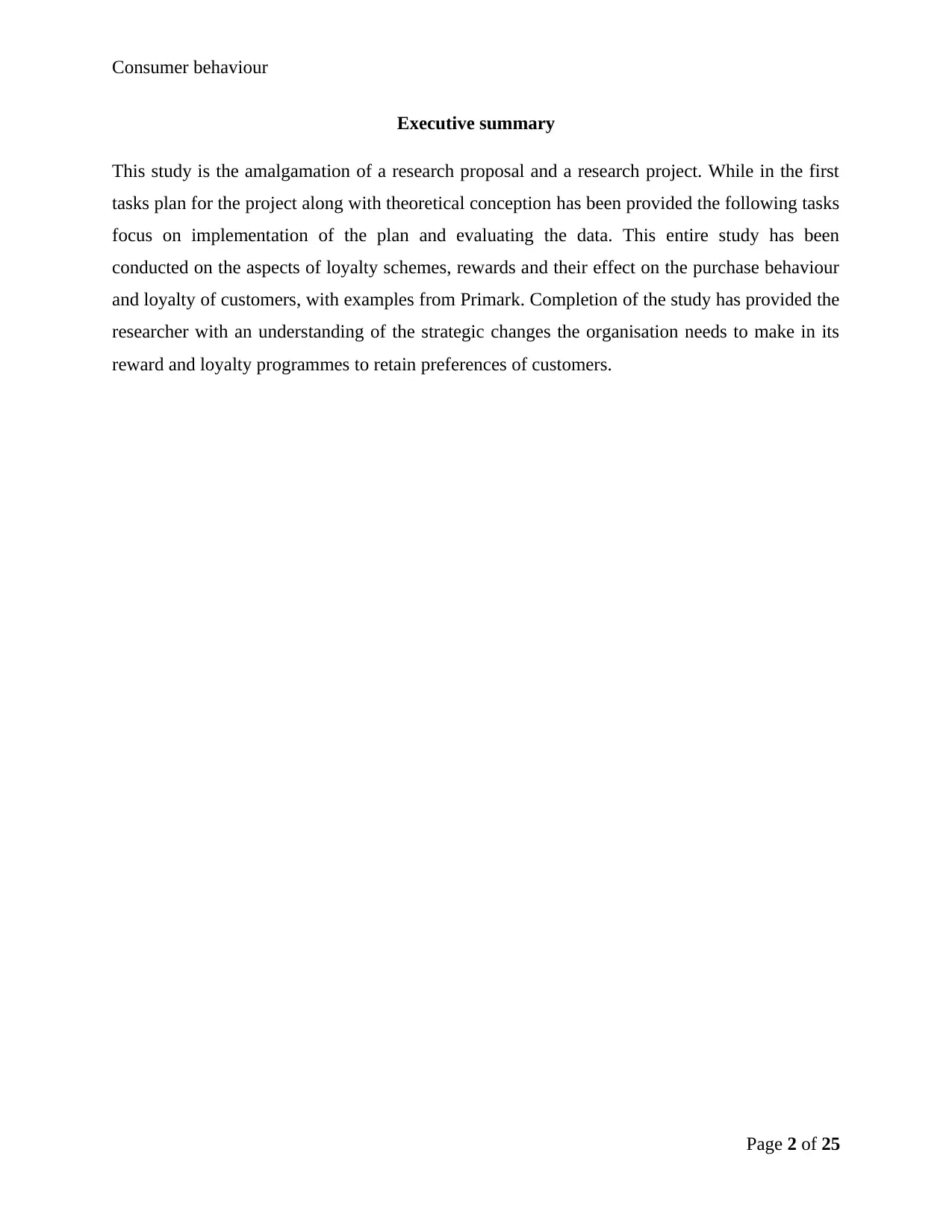
Consumer behaviour
Executive summary
This study is the amalgamation of a research proposal and a research project. While in the first
tasks plan for the project along with theoretical conception has been provided the following tasks
focus on implementation of the plan and evaluating the data. This entire study has been
conducted on the aspects of loyalty schemes, rewards and their effect on the purchase behaviour
and loyalty of customers, with examples from Primark. Completion of the study has provided the
researcher with an understanding of the strategic changes the organisation needs to make in its
reward and loyalty programmes to retain preferences of customers.
Page 2 of 25
Executive summary
This study is the amalgamation of a research proposal and a research project. While in the first
tasks plan for the project along with theoretical conception has been provided the following tasks
focus on implementation of the plan and evaluating the data. This entire study has been
conducted on the aspects of loyalty schemes, rewards and their effect on the purchase behaviour
and loyalty of customers, with examples from Primark. Completion of the study has provided the
researcher with an understanding of the strategic changes the organisation needs to make in its
reward and loyalty programmes to retain preferences of customers.
Page 2 of 25
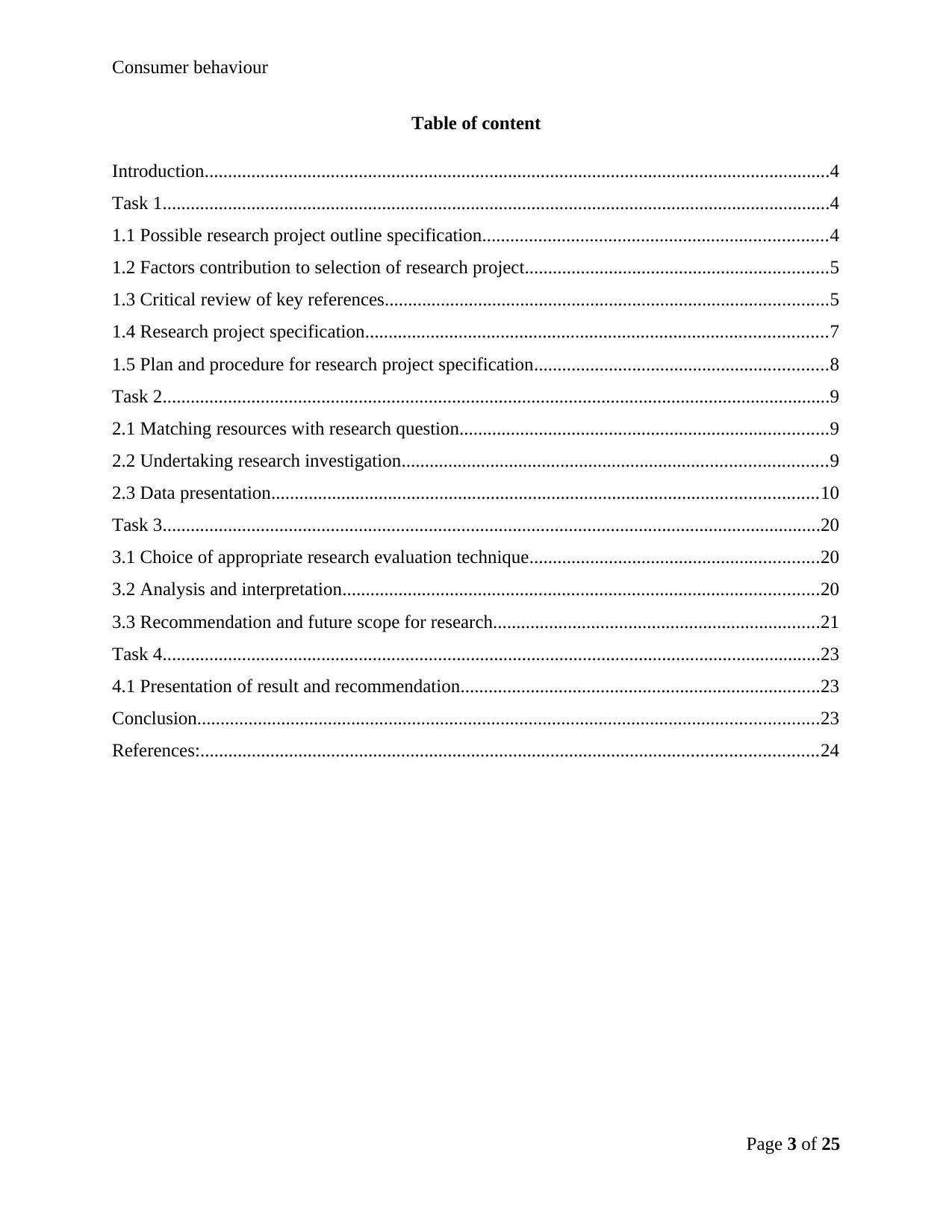
Consumer behaviour
Table of content
Introduction......................................................................................................................................4
Task 1...............................................................................................................................................4
1.1 Possible research project outline specification..........................................................................4
1.2 Factors contribution to selection of research project.................................................................5
1.3 Critical review of key references...............................................................................................5
1.4 Research project specification...................................................................................................7
1.5 Plan and procedure for research project specification...............................................................8
Task 2...............................................................................................................................................9
2.1 Matching resources with research question...............................................................................9
2.2 Undertaking research investigation...........................................................................................9
2.3 Data presentation.....................................................................................................................10
Task 3.............................................................................................................................................20
3.1 Choice of appropriate research evaluation technique..............................................................20
3.2 Analysis and interpretation......................................................................................................20
3.3 Recommendation and future scope for research......................................................................21
Task 4.............................................................................................................................................23
4.1 Presentation of result and recommendation.............................................................................23
Conclusion.....................................................................................................................................23
References:....................................................................................................................................24
Page 3 of 25
Table of content
Introduction......................................................................................................................................4
Task 1...............................................................................................................................................4
1.1 Possible research project outline specification..........................................................................4
1.2 Factors contribution to selection of research project.................................................................5
1.3 Critical review of key references...............................................................................................5
1.4 Research project specification...................................................................................................7
1.5 Plan and procedure for research project specification...............................................................8
Task 2...............................................................................................................................................9
2.1 Matching resources with research question...............................................................................9
2.2 Undertaking research investigation...........................................................................................9
2.3 Data presentation.....................................................................................................................10
Task 3.............................................................................................................................................20
3.1 Choice of appropriate research evaluation technique..............................................................20
3.2 Analysis and interpretation......................................................................................................20
3.3 Recommendation and future scope for research......................................................................21
Task 4.............................................................................................................................................23
4.1 Presentation of result and recommendation.............................................................................23
Conclusion.....................................................................................................................................23
References:....................................................................................................................................24
Page 3 of 25
⊘ This is a preview!⊘
Do you want full access?
Subscribe today to unlock all pages.

Trusted by 1+ million students worldwide
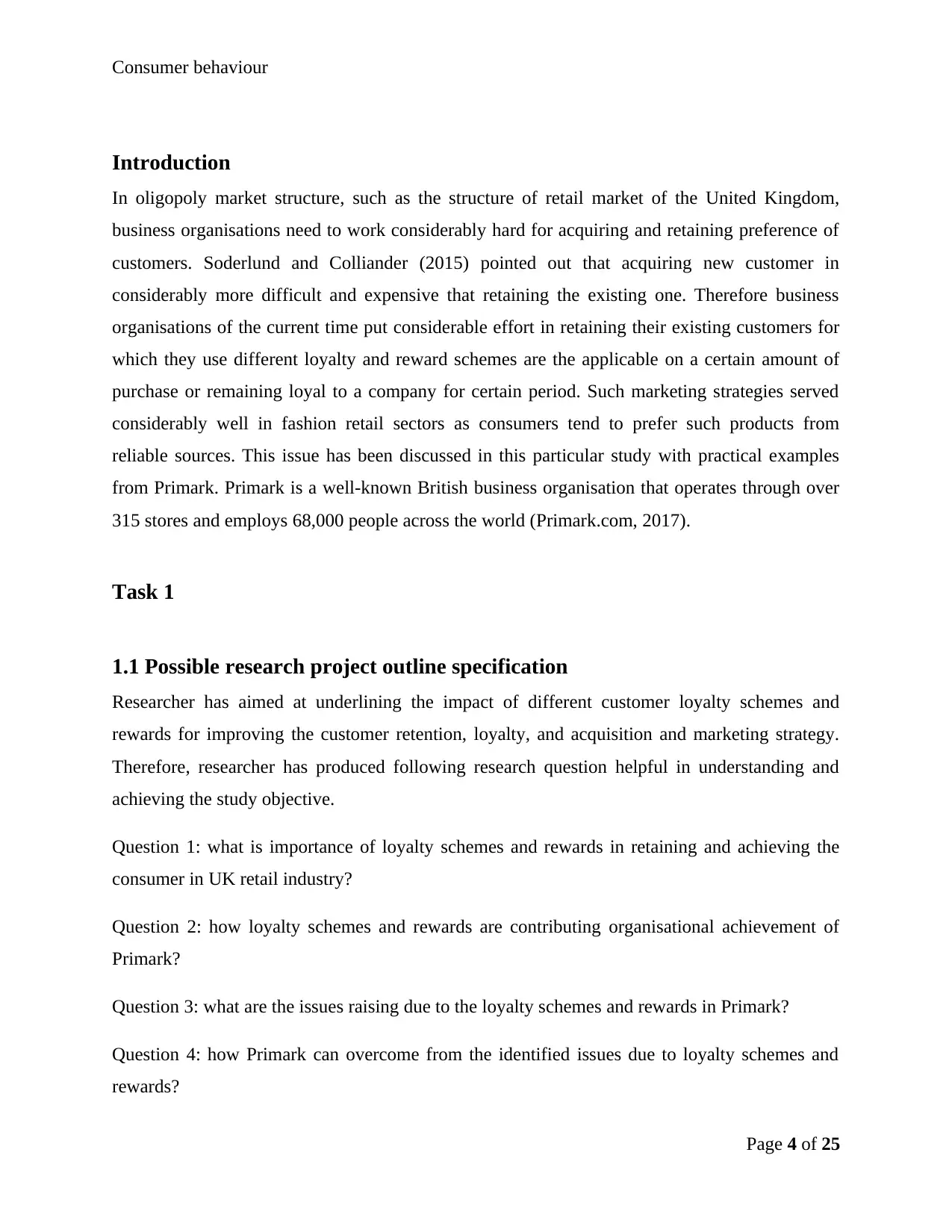
Consumer behaviour
Introduction
In oligopoly market structure, such as the structure of retail market of the United Kingdom,
business organisations need to work considerably hard for acquiring and retaining preference of
customers. Soderlund and Colliander (2015) pointed out that acquiring new customer in
considerably more difficult and expensive that retaining the existing one. Therefore business
organisations of the current time put considerable effort in retaining their existing customers for
which they use different loyalty and reward schemes are the applicable on a certain amount of
purchase or remaining loyal to a company for certain period. Such marketing strategies served
considerably well in fashion retail sectors as consumers tend to prefer such products from
reliable sources. This issue has been discussed in this particular study with practical examples
from Primark. Primark is a well-known British business organisation that operates through over
315 stores and employs 68,000 people across the world (Primark.com, 2017).
Task 1
1.1 Possible research project outline specification
Researcher has aimed at underlining the impact of different customer loyalty schemes and
rewards for improving the customer retention, loyalty, and acquisition and marketing strategy.
Therefore, researcher has produced following research question helpful in understanding and
achieving the study objective.
Question 1: what is importance of loyalty schemes and rewards in retaining and achieving the
consumer in UK retail industry?
Question 2: how loyalty schemes and rewards are contributing organisational achievement of
Primark?
Question 3: what are the issues raising due to the loyalty schemes and rewards in Primark?
Question 4: how Primark can overcome from the identified issues due to loyalty schemes and
rewards?
Page 4 of 25
Introduction
In oligopoly market structure, such as the structure of retail market of the United Kingdom,
business organisations need to work considerably hard for acquiring and retaining preference of
customers. Soderlund and Colliander (2015) pointed out that acquiring new customer in
considerably more difficult and expensive that retaining the existing one. Therefore business
organisations of the current time put considerable effort in retaining their existing customers for
which they use different loyalty and reward schemes are the applicable on a certain amount of
purchase or remaining loyal to a company for certain period. Such marketing strategies served
considerably well in fashion retail sectors as consumers tend to prefer such products from
reliable sources. This issue has been discussed in this particular study with practical examples
from Primark. Primark is a well-known British business organisation that operates through over
315 stores and employs 68,000 people across the world (Primark.com, 2017).
Task 1
1.1 Possible research project outline specification
Researcher has aimed at underlining the impact of different customer loyalty schemes and
rewards for improving the customer retention, loyalty, and acquisition and marketing strategy.
Therefore, researcher has produced following research question helpful in understanding and
achieving the study objective.
Question 1: what is importance of loyalty schemes and rewards in retaining and achieving the
consumer in UK retail industry?
Question 2: how loyalty schemes and rewards are contributing organisational achievement of
Primark?
Question 3: what are the issues raising due to the loyalty schemes and rewards in Primark?
Question 4: how Primark can overcome from the identified issues due to loyalty schemes and
rewards?
Page 4 of 25
Paraphrase This Document
Need a fresh take? Get an instant paraphrase of this document with our AI Paraphraser
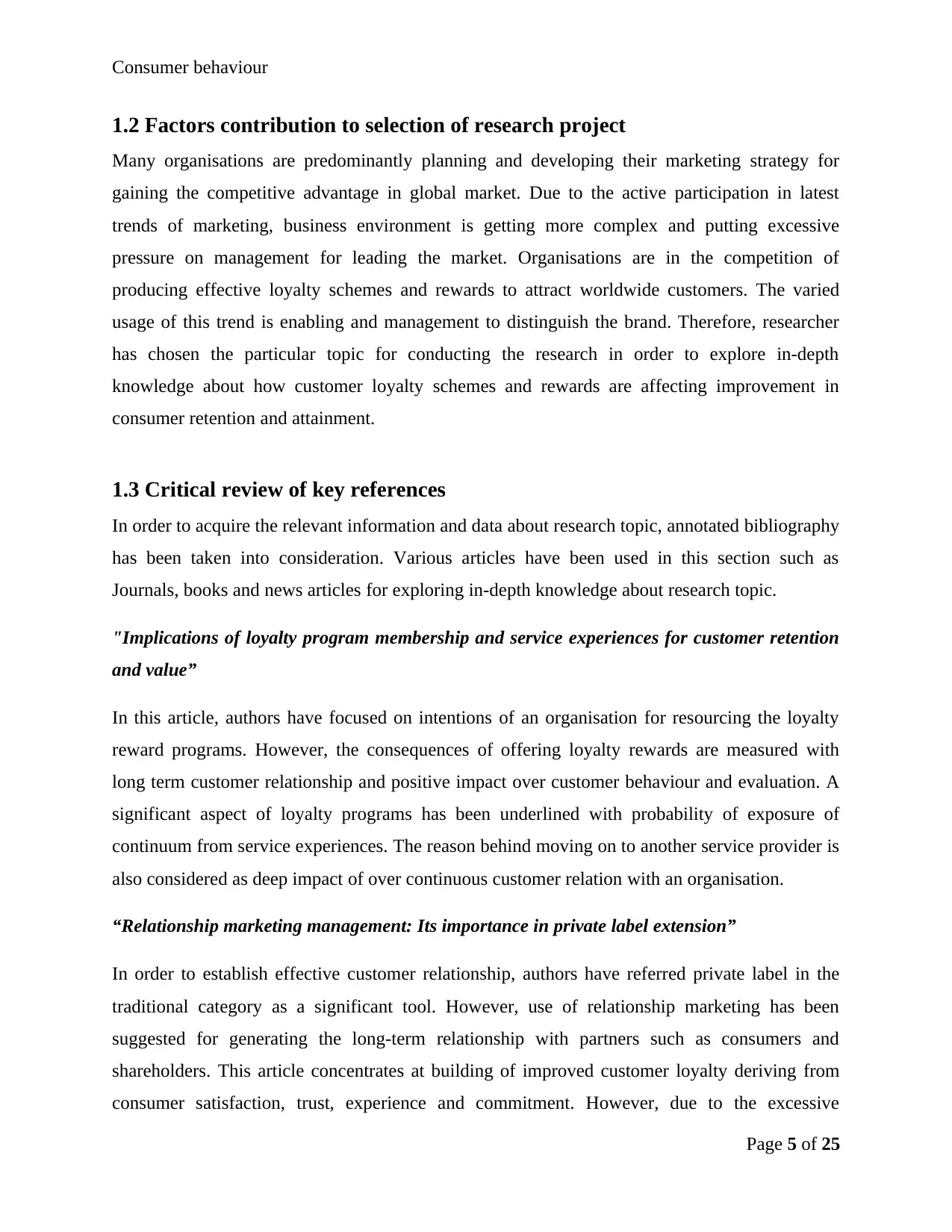
Consumer behaviour
1.2 Factors contribution to selection of research project
Many organisations are predominantly planning and developing their marketing strategy for
gaining the competitive advantage in global market. Due to the active participation in latest
trends of marketing, business environment is getting more complex and putting excessive
pressure on management for leading the market. Organisations are in the competition of
producing effective loyalty schemes and rewards to attract worldwide customers. The varied
usage of this trend is enabling and management to distinguish the brand. Therefore, researcher
has chosen the particular topic for conducting the research in order to explore in-depth
knowledge about how customer loyalty schemes and rewards are affecting improvement in
consumer retention and attainment.
1.3 Critical review of key references
In order to acquire the relevant information and data about research topic, annotated bibliography
has been taken into consideration. Various articles have been used in this section such as
Journals, books and news articles for exploring in-depth knowledge about research topic.
"Implications of loyalty program membership and service experiences for customer retention
and value”
In this article, authors have focused on intentions of an organisation for resourcing the loyalty
reward programs. However, the consequences of offering loyalty rewards are measured with
long term customer relationship and positive impact over customer behaviour and evaluation. A
significant aspect of loyalty programs has been underlined with probability of exposure of
continuum from service experiences. The reason behind moving on to another service provider is
also considered as deep impact of over continuous customer relation with an organisation.
“Relationship marketing management: Its importance in private label extension”
In order to establish effective customer relationship, authors have referred private label in the
traditional category as a significant tool. However, use of relationship marketing has been
suggested for generating the long-term relationship with partners such as consumers and
shareholders. This article concentrates at building of improved customer loyalty deriving from
consumer satisfaction, trust, experience and commitment. However, due to the excessive
Page 5 of 25
1.2 Factors contribution to selection of research project
Many organisations are predominantly planning and developing their marketing strategy for
gaining the competitive advantage in global market. Due to the active participation in latest
trends of marketing, business environment is getting more complex and putting excessive
pressure on management for leading the market. Organisations are in the competition of
producing effective loyalty schemes and rewards to attract worldwide customers. The varied
usage of this trend is enabling and management to distinguish the brand. Therefore, researcher
has chosen the particular topic for conducting the research in order to explore in-depth
knowledge about how customer loyalty schemes and rewards are affecting improvement in
consumer retention and attainment.
1.3 Critical review of key references
In order to acquire the relevant information and data about research topic, annotated bibliography
has been taken into consideration. Various articles have been used in this section such as
Journals, books and news articles for exploring in-depth knowledge about research topic.
"Implications of loyalty program membership and service experiences for customer retention
and value”
In this article, authors have focused on intentions of an organisation for resourcing the loyalty
reward programs. However, the consequences of offering loyalty rewards are measured with
long term customer relationship and positive impact over customer behaviour and evaluation. A
significant aspect of loyalty programs has been underlined with probability of exposure of
continuum from service experiences. The reason behind moving on to another service provider is
also considered as deep impact of over continuous customer relation with an organisation.
“Relationship marketing management: Its importance in private label extension”
In order to establish effective customer relationship, authors have referred private label in the
traditional category as a significant tool. However, use of relationship marketing has been
suggested for generating the long-term relationship with partners such as consumers and
shareholders. This article concentrates at building of improved customer loyalty deriving from
consumer satisfaction, trust, experience and commitment. However, due to the excessive
Page 5 of 25
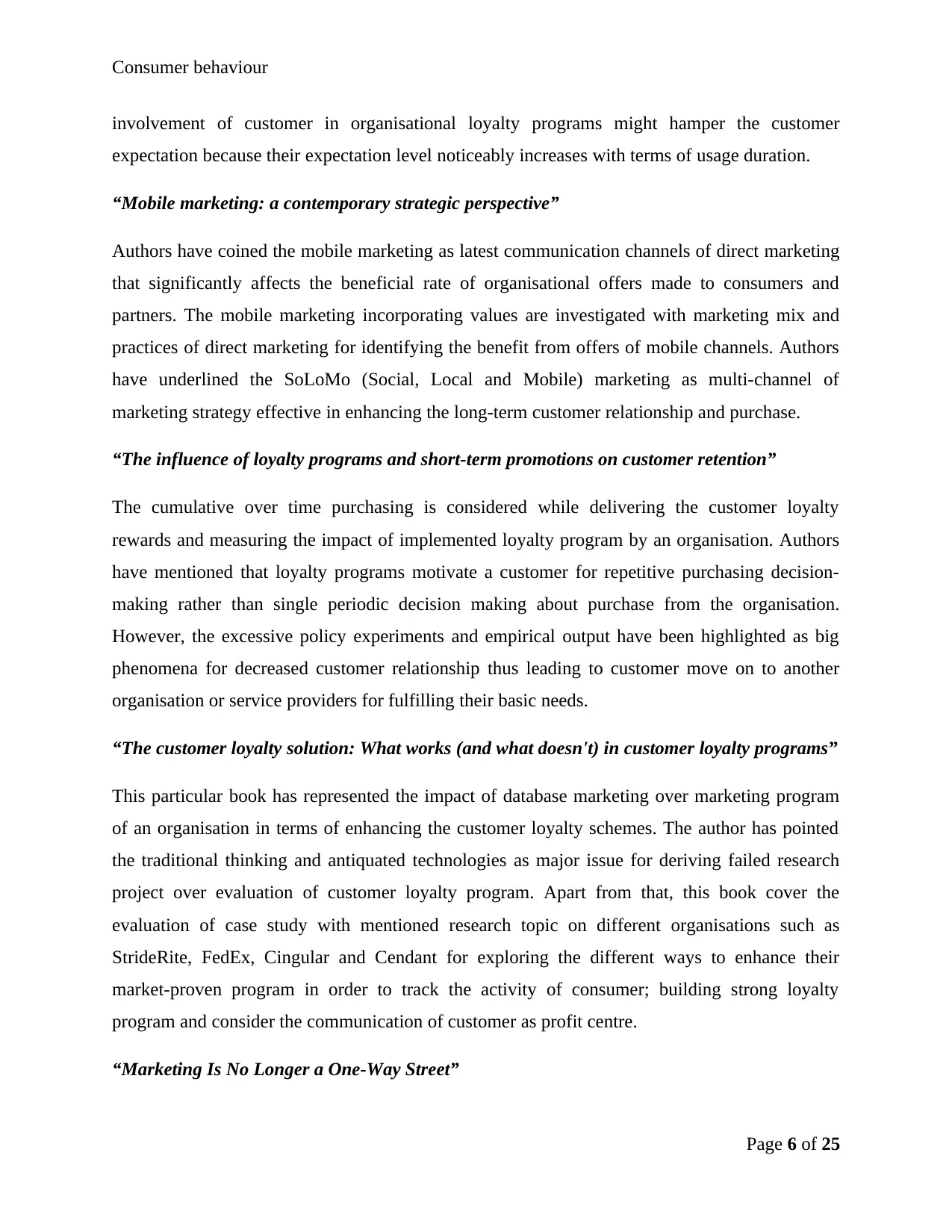
Consumer behaviour
involvement of customer in organisational loyalty programs might hamper the customer
expectation because their expectation level noticeably increases with terms of usage duration.
“Mobile marketing: a contemporary strategic perspective”
Authors have coined the mobile marketing as latest communication channels of direct marketing
that significantly affects the beneficial rate of organisational offers made to consumers and
partners. The mobile marketing incorporating values are investigated with marketing mix and
practices of direct marketing for identifying the benefit from offers of mobile channels. Authors
have underlined the SoLoMo (Social, Local and Mobile) marketing as multi-channel of
marketing strategy effective in enhancing the long-term customer relationship and purchase.
“The influence of loyalty programs and short-term promotions on customer retention”
The cumulative over time purchasing is considered while delivering the customer loyalty
rewards and measuring the impact of implemented loyalty program by an organisation. Authors
have mentioned that loyalty programs motivate a customer for repetitive purchasing decision-
making rather than single periodic decision making about purchase from the organisation.
However, the excessive policy experiments and empirical output have been highlighted as big
phenomena for decreased customer relationship thus leading to customer move on to another
organisation or service providers for fulfilling their basic needs.
“The customer loyalty solution: What works (and what doesn't) in customer loyalty programs”
This particular book has represented the impact of database marketing over marketing program
of an organisation in terms of enhancing the customer loyalty schemes. The author has pointed
the traditional thinking and antiquated technologies as major issue for deriving failed research
project over evaluation of customer loyalty program. Apart from that, this book cover the
evaluation of case study with mentioned research topic on different organisations such as
StrideRite, FedEx, Cingular and Cendant for exploring the different ways to enhance their
market-proven program in order to track the activity of consumer; building strong loyalty
program and consider the communication of customer as profit centre.
“Marketing Is No Longer a One-Way Street”
Page 6 of 25
involvement of customer in organisational loyalty programs might hamper the customer
expectation because their expectation level noticeably increases with terms of usage duration.
“Mobile marketing: a contemporary strategic perspective”
Authors have coined the mobile marketing as latest communication channels of direct marketing
that significantly affects the beneficial rate of organisational offers made to consumers and
partners. The mobile marketing incorporating values are investigated with marketing mix and
practices of direct marketing for identifying the benefit from offers of mobile channels. Authors
have underlined the SoLoMo (Social, Local and Mobile) marketing as multi-channel of
marketing strategy effective in enhancing the long-term customer relationship and purchase.
“The influence of loyalty programs and short-term promotions on customer retention”
The cumulative over time purchasing is considered while delivering the customer loyalty
rewards and measuring the impact of implemented loyalty program by an organisation. Authors
have mentioned that loyalty programs motivate a customer for repetitive purchasing decision-
making rather than single periodic decision making about purchase from the organisation.
However, the excessive policy experiments and empirical output have been highlighted as big
phenomena for decreased customer relationship thus leading to customer move on to another
organisation or service providers for fulfilling their basic needs.
“The customer loyalty solution: What works (and what doesn't) in customer loyalty programs”
This particular book has represented the impact of database marketing over marketing program
of an organisation in terms of enhancing the customer loyalty schemes. The author has pointed
the traditional thinking and antiquated technologies as major issue for deriving failed research
project over evaluation of customer loyalty program. Apart from that, this book cover the
evaluation of case study with mentioned research topic on different organisations such as
StrideRite, FedEx, Cingular and Cendant for exploring the different ways to enhance their
market-proven program in order to track the activity of consumer; building strong loyalty
program and consider the communication of customer as profit centre.
“Marketing Is No Longer a One-Way Street”
Page 6 of 25
⊘ This is a preview!⊘
Do you want full access?
Subscribe today to unlock all pages.

Trusted by 1+ million students worldwide
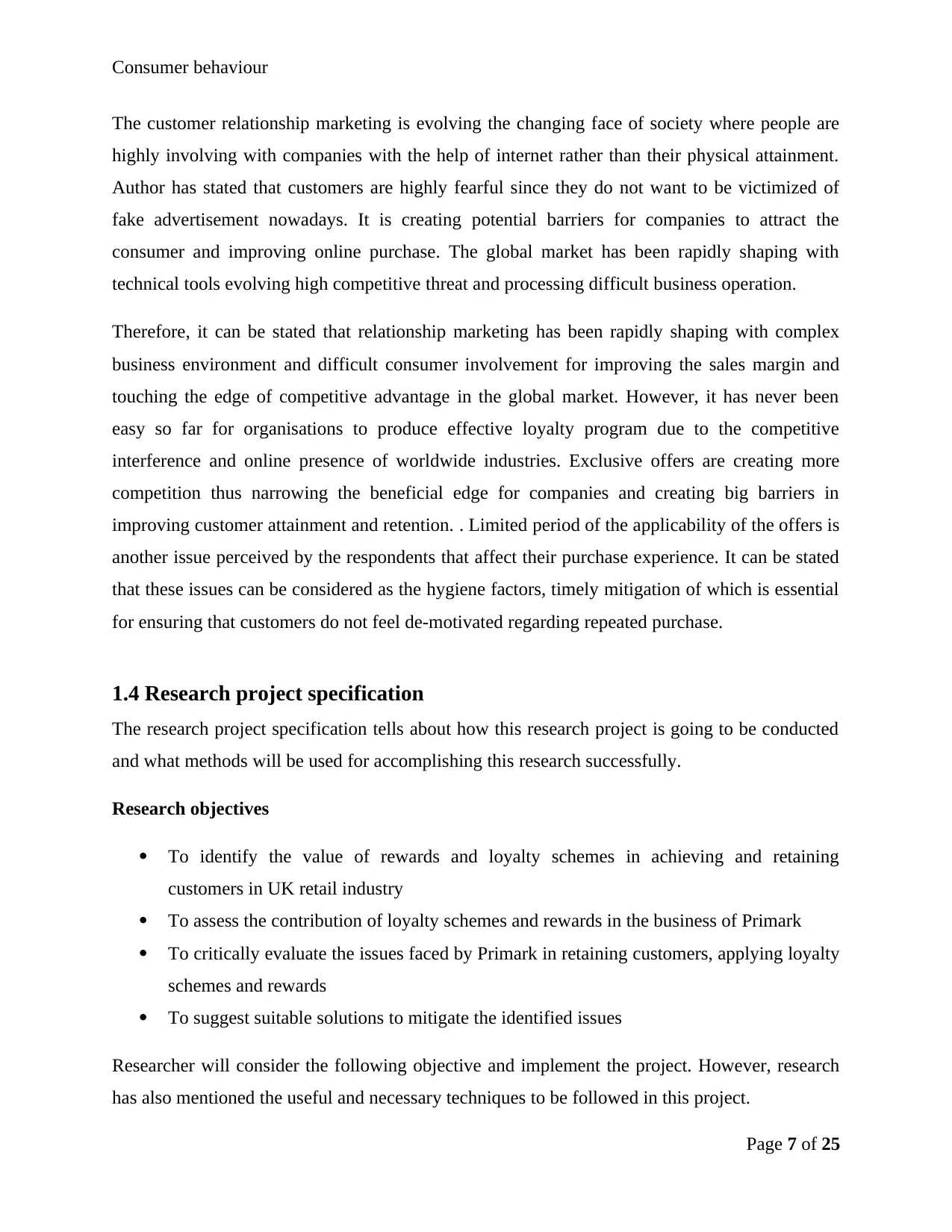
Consumer behaviour
The customer relationship marketing is evolving the changing face of society where people are
highly involving with companies with the help of internet rather than their physical attainment.
Author has stated that customers are highly fearful since they do not want to be victimized of
fake advertisement nowadays. It is creating potential barriers for companies to attract the
consumer and improving online purchase. The global market has been rapidly shaping with
technical tools evolving high competitive threat and processing difficult business operation.
Therefore, it can be stated that relationship marketing has been rapidly shaping with complex
business environment and difficult consumer involvement for improving the sales margin and
touching the edge of competitive advantage in the global market. However, it has never been
easy so far for organisations to produce effective loyalty program due to the competitive
interference and online presence of worldwide industries. Exclusive offers are creating more
competition thus narrowing the beneficial edge for companies and creating big barriers in
improving customer attainment and retention. . Limited period of the applicability of the offers is
another issue perceived by the respondents that affect their purchase experience. It can be stated
that these issues can be considered as the hygiene factors, timely mitigation of which is essential
for ensuring that customers do not feel de-motivated regarding repeated purchase.
1.4 Research project specification
The research project specification tells about how this research project is going to be conducted
and what methods will be used for accomplishing this research successfully.
Research objectives
To identify the value of rewards and loyalty schemes in achieving and retaining
customers in UK retail industry
To assess the contribution of loyalty schemes and rewards in the business of Primark
To critically evaluate the issues faced by Primark in retaining customers, applying loyalty
schemes and rewards
To suggest suitable solutions to mitigate the identified issues
Researcher will consider the following objective and implement the project. However, research
has also mentioned the useful and necessary techniques to be followed in this project.
Page 7 of 25
The customer relationship marketing is evolving the changing face of society where people are
highly involving with companies with the help of internet rather than their physical attainment.
Author has stated that customers are highly fearful since they do not want to be victimized of
fake advertisement nowadays. It is creating potential barriers for companies to attract the
consumer and improving online purchase. The global market has been rapidly shaping with
technical tools evolving high competitive threat and processing difficult business operation.
Therefore, it can be stated that relationship marketing has been rapidly shaping with complex
business environment and difficult consumer involvement for improving the sales margin and
touching the edge of competitive advantage in the global market. However, it has never been
easy so far for organisations to produce effective loyalty program due to the competitive
interference and online presence of worldwide industries. Exclusive offers are creating more
competition thus narrowing the beneficial edge for companies and creating big barriers in
improving customer attainment and retention. . Limited period of the applicability of the offers is
another issue perceived by the respondents that affect their purchase experience. It can be stated
that these issues can be considered as the hygiene factors, timely mitigation of which is essential
for ensuring that customers do not feel de-motivated regarding repeated purchase.
1.4 Research project specification
The research project specification tells about how this research project is going to be conducted
and what methods will be used for accomplishing this research successfully.
Research objectives
To identify the value of rewards and loyalty schemes in achieving and retaining
customers in UK retail industry
To assess the contribution of loyalty schemes and rewards in the business of Primark
To critically evaluate the issues faced by Primark in retaining customers, applying loyalty
schemes and rewards
To suggest suitable solutions to mitigate the identified issues
Researcher will consider the following objective and implement the project. However, research
has also mentioned the useful and necessary techniques to be followed in this project.
Page 7 of 25
Paraphrase This Document
Need a fresh take? Get an instant paraphrase of this document with our AI Paraphraser
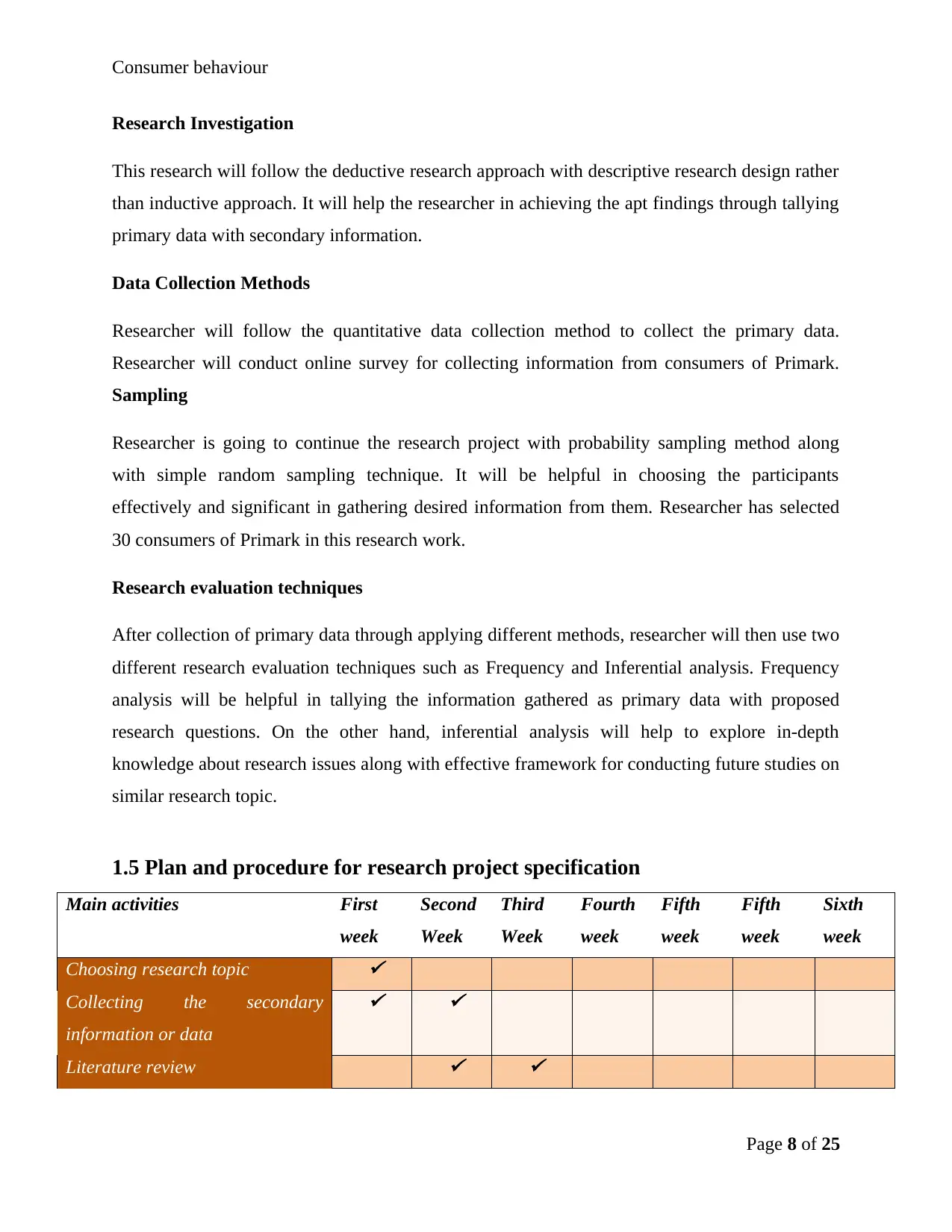
Consumer behaviour
Research Investigation
This research will follow the deductive research approach with descriptive research design rather
than inductive approach. It will help the researcher in achieving the apt findings through tallying
primary data with secondary information.
Data Collection Methods
Researcher will follow the quantitative data collection method to collect the primary data.
Researcher will conduct online survey for collecting information from consumers of Primark.
Sampling
Researcher is going to continue the research project with probability sampling method along
with simple random sampling technique. It will be helpful in choosing the participants
effectively and significant in gathering desired information from them. Researcher has selected
30 consumers of Primark in this research work.
Research evaluation techniques
After collection of primary data through applying different methods, researcher will then use two
different research evaluation techniques such as Frequency and Inferential analysis. Frequency
analysis will be helpful in tallying the information gathered as primary data with proposed
research questions. On the other hand, inferential analysis will help to explore in-depth
knowledge about research issues along with effective framework for conducting future studies on
similar research topic.
1.5 Plan and procedure for research project specification
Main activities First
week
Second
Week
Third
Week
Fourth
week
Fifth
week
Fifth
week
Sixth
week
Choosing research topic
Collecting the secondary
information or data
Literature review
Page 8 of 25
Research Investigation
This research will follow the deductive research approach with descriptive research design rather
than inductive approach. It will help the researcher in achieving the apt findings through tallying
primary data with secondary information.
Data Collection Methods
Researcher will follow the quantitative data collection method to collect the primary data.
Researcher will conduct online survey for collecting information from consumers of Primark.
Sampling
Researcher is going to continue the research project with probability sampling method along
with simple random sampling technique. It will be helpful in choosing the participants
effectively and significant in gathering desired information from them. Researcher has selected
30 consumers of Primark in this research work.
Research evaluation techniques
After collection of primary data through applying different methods, researcher will then use two
different research evaluation techniques such as Frequency and Inferential analysis. Frequency
analysis will be helpful in tallying the information gathered as primary data with proposed
research questions. On the other hand, inferential analysis will help to explore in-depth
knowledge about research issues along with effective framework for conducting future studies on
similar research topic.
1.5 Plan and procedure for research project specification
Main activities First
week
Second
Week
Third
Week
Fourth
week
Fifth
week
Fifth
week
Sixth
week
Choosing research topic
Collecting the secondary
information or data
Literature review
Page 8 of 25
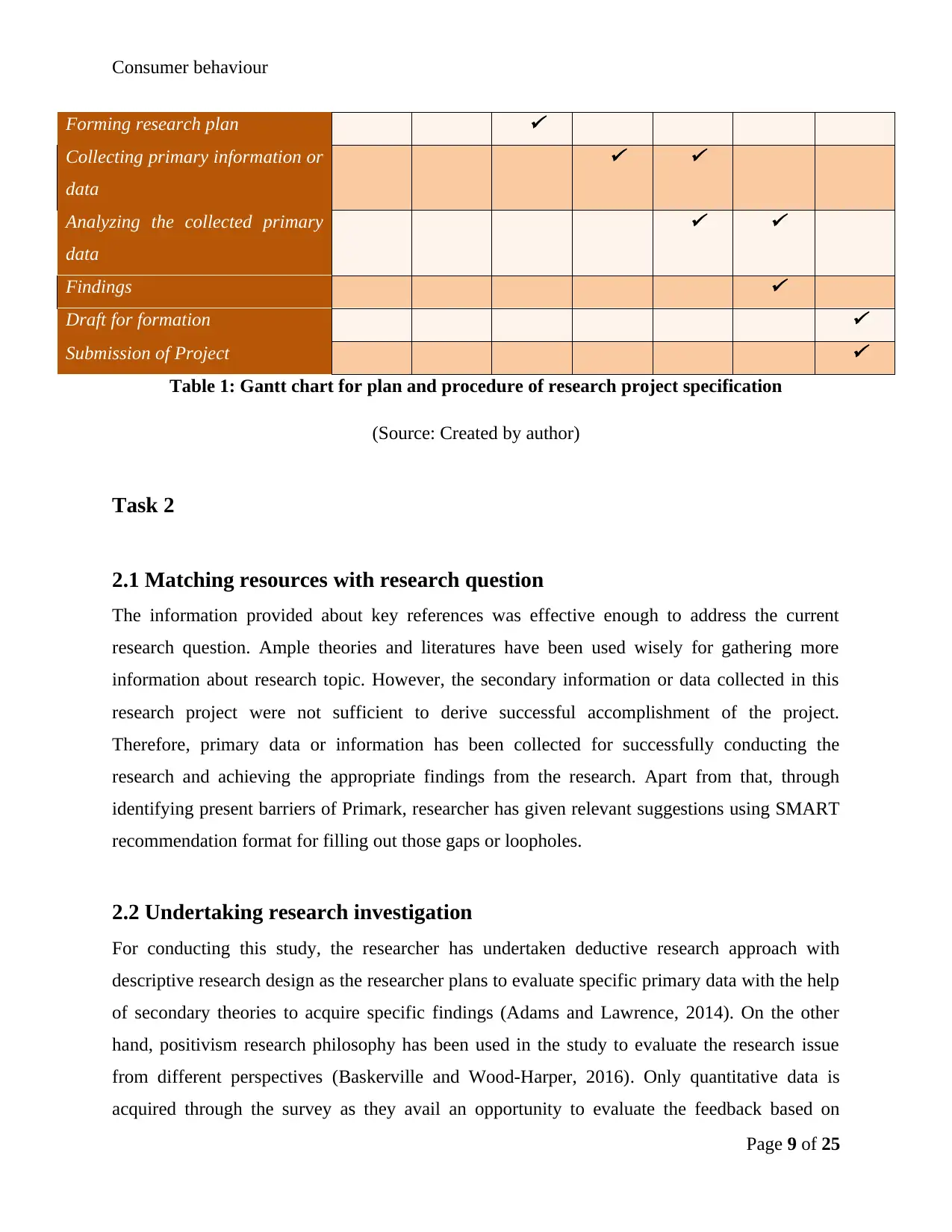
Consumer behaviour
Forming research plan
Collecting primary information or
data
Analyzing the collected primary
data
Findings
Draft for formation
Submission of Project
Table 1: Gantt chart for plan and procedure of research project specification
(Source: Created by author)
Task 2
2.1 Matching resources with research question
The information provided about key references was effective enough to address the current
research question. Ample theories and literatures have been used wisely for gathering more
information about research topic. However, the secondary information or data collected in this
research project were not sufficient to derive successful accomplishment of the project.
Therefore, primary data or information has been collected for successfully conducting the
research and achieving the appropriate findings from the research. Apart from that, through
identifying present barriers of Primark, researcher has given relevant suggestions using SMART
recommendation format for filling out those gaps or loopholes.
2.2 Undertaking research investigation
For conducting this study, the researcher has undertaken deductive research approach with
descriptive research design as the researcher plans to evaluate specific primary data with the help
of secondary theories to acquire specific findings (Adams and Lawrence, 2014). On the other
hand, positivism research philosophy has been used in the study to evaluate the research issue
from different perspectives (Baskerville and Wood-Harper, 2016). Only quantitative data is
acquired through the survey as they avail an opportunity to evaluate the feedback based on
Page 9 of 25
Forming research plan
Collecting primary information or
data
Analyzing the collected primary
data
Findings
Draft for formation
Submission of Project
Table 1: Gantt chart for plan and procedure of research project specification
(Source: Created by author)
Task 2
2.1 Matching resources with research question
The information provided about key references was effective enough to address the current
research question. Ample theories and literatures have been used wisely for gathering more
information about research topic. However, the secondary information or data collected in this
research project were not sufficient to derive successful accomplishment of the project.
Therefore, primary data or information has been collected for successfully conducting the
research and achieving the appropriate findings from the research. Apart from that, through
identifying present barriers of Primark, researcher has given relevant suggestions using SMART
recommendation format for filling out those gaps or loopholes.
2.2 Undertaking research investigation
For conducting this study, the researcher has undertaken deductive research approach with
descriptive research design as the researcher plans to evaluate specific primary data with the help
of secondary theories to acquire specific findings (Adams and Lawrence, 2014). On the other
hand, positivism research philosophy has been used in the study to evaluate the research issue
from different perspectives (Baskerville and Wood-Harper, 2016). Only quantitative data is
acquired through the survey as they avail an opportunity to evaluate the feedback based on
Page 9 of 25
⊘ This is a preview!⊘
Do you want full access?
Subscribe today to unlock all pages.

Trusted by 1+ million students worldwide
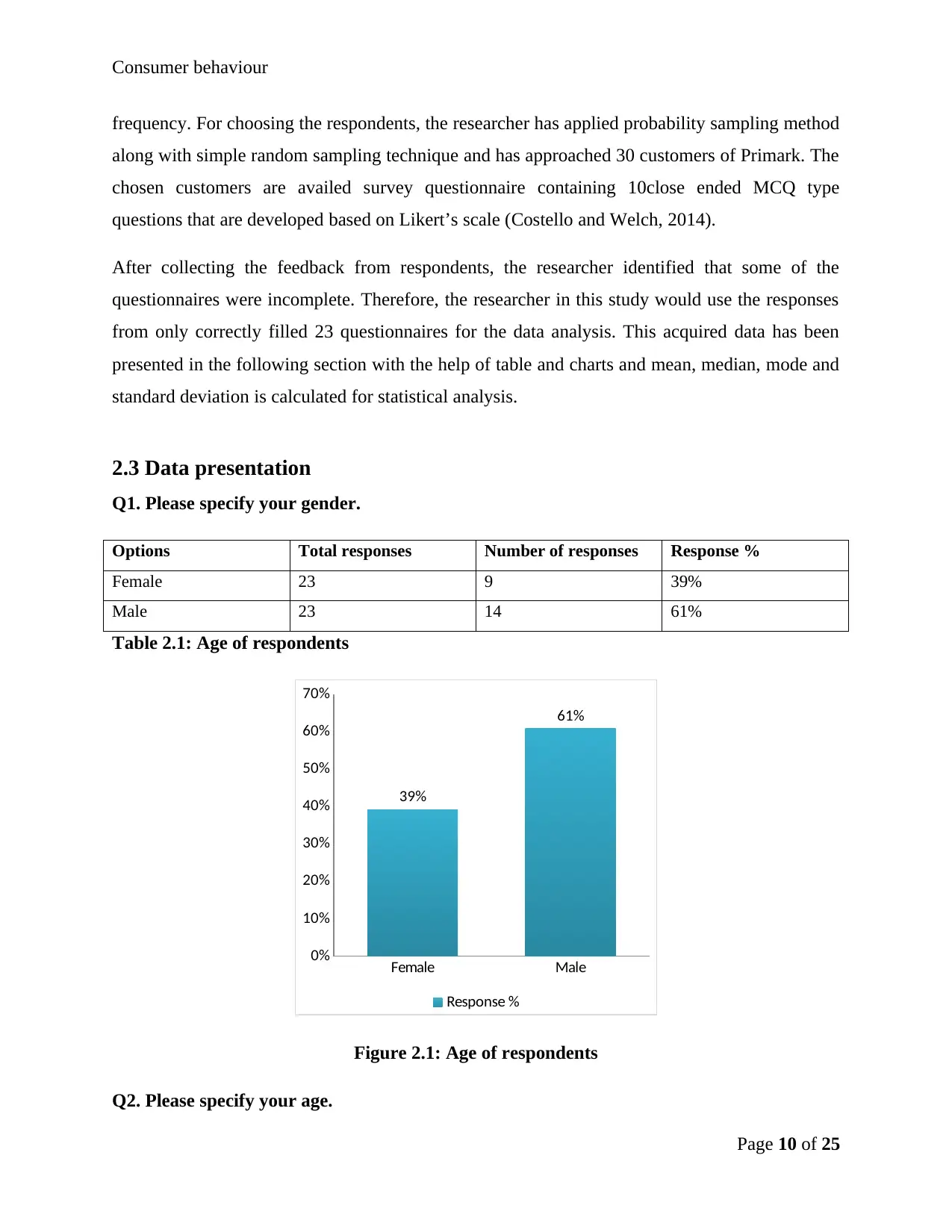
Consumer behaviour
frequency. For choosing the respondents, the researcher has applied probability sampling method
along with simple random sampling technique and has approached 30 customers of Primark. The
chosen customers are availed survey questionnaire containing 10close ended MCQ type
questions that are developed based on Likert’s scale (Costello and Welch, 2014).
After collecting the feedback from respondents, the researcher identified that some of the
questionnaires were incomplete. Therefore, the researcher in this study would use the responses
from only correctly filled 23 questionnaires for the data analysis. This acquired data has been
presented in the following section with the help of table and charts and mean, median, mode and
standard deviation is calculated for statistical analysis.
2.3 Data presentation
Q1. Please specify your gender.
Options Total responses Number of responses Response %
Female 23 9 39%
Male 23 14 61%
Table 2.1: Age of respondents
Female Male
0%
10%
20%
30%
40%
50%
60%
70%
39%
61%
Response %
Figure 2.1: Age of respondents
Q2. Please specify your age.
Page 10 of 25
frequency. For choosing the respondents, the researcher has applied probability sampling method
along with simple random sampling technique and has approached 30 customers of Primark. The
chosen customers are availed survey questionnaire containing 10close ended MCQ type
questions that are developed based on Likert’s scale (Costello and Welch, 2014).
After collecting the feedback from respondents, the researcher identified that some of the
questionnaires were incomplete. Therefore, the researcher in this study would use the responses
from only correctly filled 23 questionnaires for the data analysis. This acquired data has been
presented in the following section with the help of table and charts and mean, median, mode and
standard deviation is calculated for statistical analysis.
2.3 Data presentation
Q1. Please specify your gender.
Options Total responses Number of responses Response %
Female 23 9 39%
Male 23 14 61%
Table 2.1: Age of respondents
Female Male
0%
10%
20%
30%
40%
50%
60%
70%
39%
61%
Response %
Figure 2.1: Age of respondents
Q2. Please specify your age.
Page 10 of 25
Paraphrase This Document
Need a fresh take? Get an instant paraphrase of this document with our AI Paraphraser
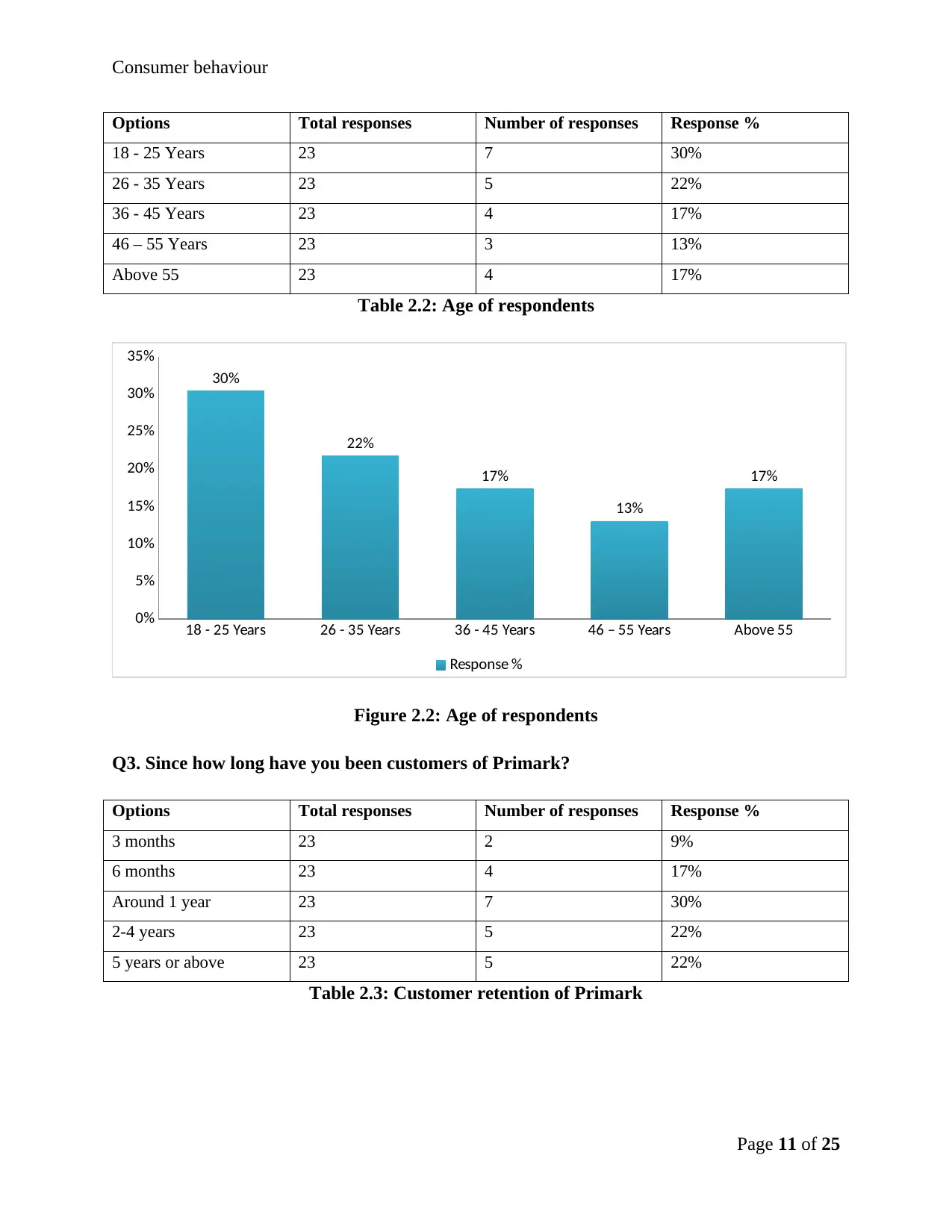
Consumer behaviour
Options Total responses Number of responses Response %
18 - 25 Years 23 7 30%
26 - 35 Years 23 5 22%
36 - 45 Years 23 4 17%
46 – 55 Years 23 3 13%
Above 55 23 4 17%
Table 2.2: Age of respondents
18 - 25 Years 26 - 35 Years 36 - 45 Years 46 – 55 Years Above 55
0%
5%
10%
15%
20%
25%
30%
35%
30%
22%
17%
13%
17%
Response %
Figure 2.2: Age of respondents
Q3. Since how long have you been customers of Primark?
Options Total responses Number of responses Response %
3 months 23 2 9%
6 months 23 4 17%
Around 1 year 23 7 30%
2-4 years 23 5 22%
5 years or above 23 5 22%
Table 2.3: Customer retention of Primark
Page 11 of 25
Options Total responses Number of responses Response %
18 - 25 Years 23 7 30%
26 - 35 Years 23 5 22%
36 - 45 Years 23 4 17%
46 – 55 Years 23 3 13%
Above 55 23 4 17%
Table 2.2: Age of respondents
18 - 25 Years 26 - 35 Years 36 - 45 Years 46 – 55 Years Above 55
0%
5%
10%
15%
20%
25%
30%
35%
30%
22%
17%
13%
17%
Response %
Figure 2.2: Age of respondents
Q3. Since how long have you been customers of Primark?
Options Total responses Number of responses Response %
3 months 23 2 9%
6 months 23 4 17%
Around 1 year 23 7 30%
2-4 years 23 5 22%
5 years or above 23 5 22%
Table 2.3: Customer retention of Primark
Page 11 of 25
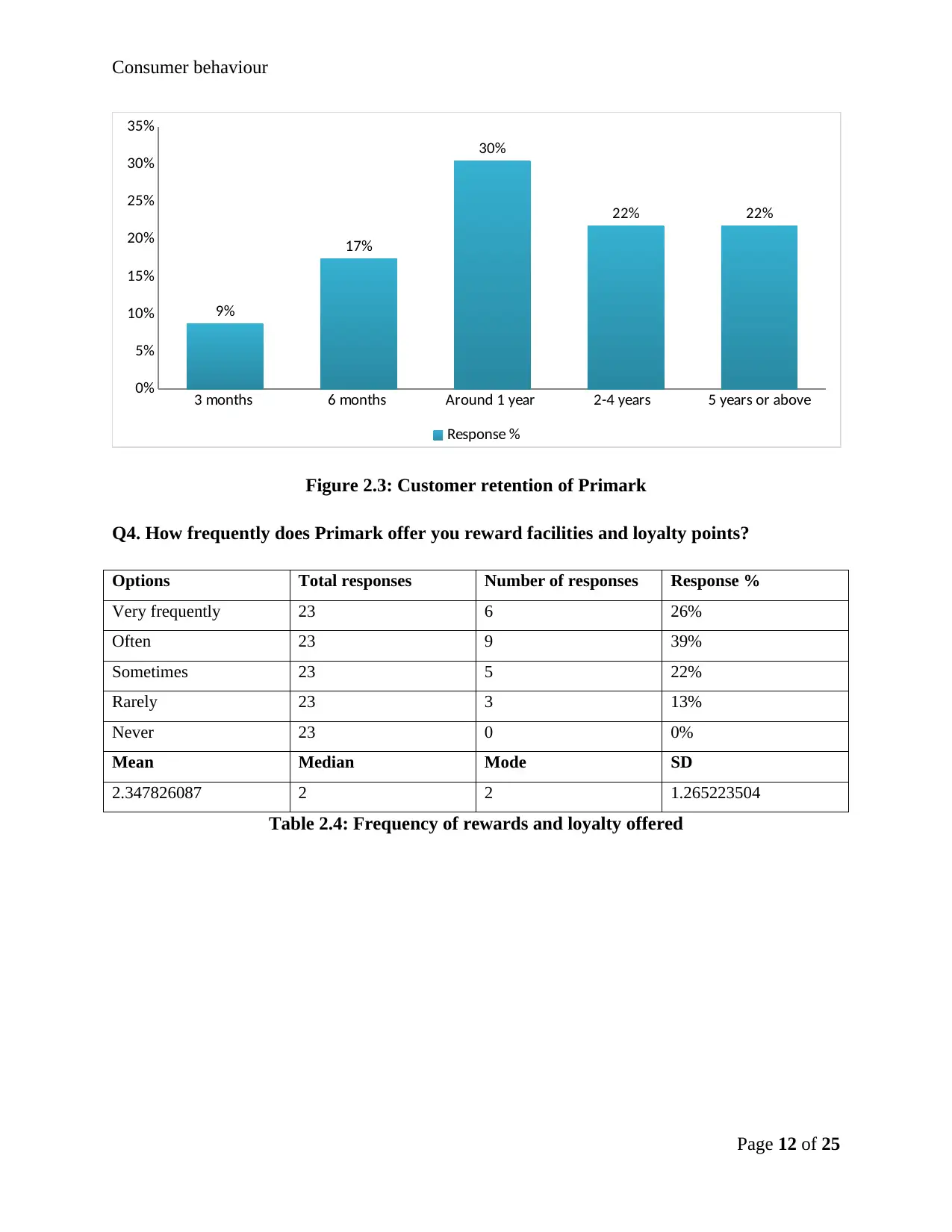
Consumer behaviour
3 months 6 months Around 1 year 2-4 years 5 years or above
0%
5%
10%
15%
20%
25%
30%
35%
9%
17%
30%
22% 22%
Response %
Figure 2.3: Customer retention of Primark
Q4. How frequently does Primark offer you reward facilities and loyalty points?
Options Total responses Number of responses Response %
Very frequently 23 6 26%
Often 23 9 39%
Sometimes 23 5 22%
Rarely 23 3 13%
Never 23 0 0%
Mean Median Mode SD
2.347826087 2 2 1.265223504
Table 2.4: Frequency of rewards and loyalty offered
Page 12 of 25
3 months 6 months Around 1 year 2-4 years 5 years or above
0%
5%
10%
15%
20%
25%
30%
35%
9%
17%
30%
22% 22%
Response %
Figure 2.3: Customer retention of Primark
Q4. How frequently does Primark offer you reward facilities and loyalty points?
Options Total responses Number of responses Response %
Very frequently 23 6 26%
Often 23 9 39%
Sometimes 23 5 22%
Rarely 23 3 13%
Never 23 0 0%
Mean Median Mode SD
2.347826087 2 2 1.265223504
Table 2.4: Frequency of rewards and loyalty offered
Page 12 of 25
⊘ This is a preview!⊘
Do you want full access?
Subscribe today to unlock all pages.

Trusted by 1+ million students worldwide
1 out of 25
Related Documents
Your All-in-One AI-Powered Toolkit for Academic Success.
+13062052269
info@desklib.com
Available 24*7 on WhatsApp / Email
![[object Object]](/_next/static/media/star-bottom.7253800d.svg)
Unlock your academic potential
Copyright © 2020–2025 A2Z Services. All Rights Reserved. Developed and managed by ZUCOL.





